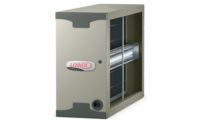HVAC systems must be running at peak performance to fight some of the root causes of poor IAQ, namely damp and poorly ventilated indoor environments. “Damp indoor environments contribute to elevated levels of microorganisms, their byproducts, insects, and other pests,” said Ian Cull, technical director for the Indoor Air Quality Association (IAQA). “Although the exact mechanisms may not be fully understood, there is sufficient evidence that dampness contributes to poor IAQ.
“Insufficient ventilation is another major contributor to poor indoor air quality. Because many products give off volatile organic compounds (VOCs), the emissions should be extracted and diluted via ventilation. VOCs from personal care products, cleaners and building materials will be found in most every indoor environment.”
Filtration - or lack of - is a bugaboo, too. “Filtration serves a dual role removing particulates that pollute the air as they move through the occupied space so it can’t be inhaled,” said Gregg Burnett, CEO of Dust Free, LP. “Filtration also contributes to HVAC system hygiene by reducing the amount of particulates that collect in the HVAC system at point of inertia where the air changes course and the particulate matter is lodged onto a surface such as a corner in a plenum, spackling on a ceiling, vents on a grille.”
So how can HVAC contractors ensure that customers have healthy indoor air? The answer is simple - proper maintenance - which results in better IAQ.
Tom Ruse, marketing communications manager for Aprilaire said that keeping the key components of any HVAC system properly maintained and in top working order has a lasting effect on indoor air quality. “Since most of the air in the residential envelope will at some point pass through the HVAC system, the air will be affected by the level of hygiene in the system,” he said. “As the air moves from the occupied spaces into the return air path the grilles, ductwork, plenums, blowers, coils, and heat exchangers will either make the air quality better, or the system will make the air quality worse depending on what the air is coming in contact with as it migrates through the system.”
Burnett said that some symptoms are not as obvious as clogged filters, leaky ductwork, or dirty coils. Change in seasons along with increased ventilation can affect overall comfort of the indoor air depending on the respiratory sensitivities of the occupant. “Other non-typical contributors to the air quality level are the quality and type of vacuuming system used in the home, the level of dry cleaned clothes off-gassing naphtha in the home, the amount and frequency of water spills on the floors over time from washing machines, freezers that defrost, dish washers that overflow, snow covered shoes that melt into wood base boards,” he said. “All of these moisture events over time can set up mold colonies that will contribute negatively to IAQ.”
GETTING MORE SPECIFIC
Michael Atchley of Oren Atchley Co., Inc. Fort Smith, Arkansas gave a checklist of problem areas and solutions for HVAC technicians to look out for:“You’d have to start with the system filter. Though most filters aren’t intended to literally clean the air in the living space, a good filter that does not excessively reduce airflow will keep the blower and indoor coil clean. A clean blower and coil is much better for IAQ than one that is coated with dust, dirt, and other items that only a microbiologist could identify.
“Next, we’ve seen many UV lights with bulbs that aren’t functioning anymore. At some point the homeowner felt the need to invest in the UV fixture, but it’s doing them no good if the bulbs are five years old. Changing the bulbs should be a part of the maintenance program to prevent mold growth on the indoor equipment.
“Humidity levels also play a big role in IAQ. Does the system have enhanced dehumidification capabilities? If so, is it wired properly and is the dehumidistat programmed properly? Is there a humidifier that is used in the winter? Is it working? Has the humidifier pad been replaced?
“Finally, if the customer is lucky enough to have a source of fresh air being introduced into the house through an ERV or even something simpler like a small fresh air duct tapped into the return side of the duct system, the technician should check to see that the fresh air system is working properly. If designed and operating properly the house should be under a slightly positive pressure. While outdoor conditions (i.e. wind) can certainly have an impact on the pressure of the house, on a calm day the technician can use a simple smoke puffer while the HVAC system is running to see if the house is under a positive or negative pressure. Again, a positive pressure is better for IAQ than is a negative pressure.”
“Proper air filtration plays a key role in fighting indoor air pollution,” said Burnett. “High efficiency air filtration does much more to keep contaminants and dirt from re-entering the air stream when a system blower operates. Trapping these contaminants not only helps maintain cleaner, healthier air throughout the home, but also keeps more dirt and grime from accumulating within the HVAC system, which helps maintain its efficiency.”
Duct cleaning and duct sealing can have a major effect on IAQ. According to Atchley, “Dirty ducts are an easy thing to address but duct sealing is rarely discussed. Aside from efficiency and capacity loss, leaking ductwork, particularly on the return side of the system will bring in air from areas that are usually not being conditioned. Systems in attics and unfinished basements that have leaking return air ducts are drawing in air from hot attics and musty basements and distributing that air throughout the living space. Seal the ducts and the problem goes away.”
Jolene Methvin of Bay Air Conditioning, Ocala, Florida, said, “We are in the South, so we are always worried about moisture and mold. Things to watch on maintenance to help control microbial growth would include chemically cleaning the coils, cleaning/flushing the condensate pan and drain line and treat the pan with condensate tabs, and pull and clean the blower to enable proper cfm, and prevent too low exiting air temperature which will cause the cabinet and ductwork to sweat.”
Methvin added that checking static pressure is a key, too. “The technician should check the total static pressure, as well as the drop across the coil for the same reason,” she said. “Also, static should be checked to ensure proper airflow. Coil static drop is critical because a dirty coil can cause the unit to hold water in the pan, can cause the unit to sweat, and on shut down the drain pan may overflow causing water damage.”
Clean coils have a dramatic impact on something else, too - energy bills. “Improperly maintained cooling coils can result in higher energy bills as the equipment is operating inefficiently,” Ruse said. “This can also result in the home being uncomfortable as the equipment tries to maintain the desired set point. Most homeowners gauge indoor air quality on their level of comfort, i.e., how warm or cold it is, how humid or dry the home feels. If the home is too humid, the usual conclusion is that there is something wrong with the HVAC system. IAQ products, such as a dehumidifier or humidifier, work behind the scenes with an HVAC system to keep the home comfortable.”
TRAINING AVAILABLE
Proper system maintenance is the goal of any HVAC technician training because this knowledge can be used during system tune-ups and passed on to customers. Cull said that knowledge should go far beyond basic training.“Indoor air quality is a vast field covering dozens of different contaminants,” he said. “Before HVAC contractors even consider training, they should first research the licensing requirements in force in their jurisdiction. States may have restrictions on work related to key indoor air quality contaminants such as asbestos, lead, radon and mold. The state licensing requirements, to a certain extent, will dictate what education is required.
“Taking classes to meet a state requirement won’t prepare HVAC contractors for the wide variety of problems found in the field. I would recommend a broad base of education related to contaminants, their health effects, building science, performing assessments, and sampling.”
Ruse said, “Aprilaire provides professional sales training based on best practices and past contractors’ business success stories. Technical training (installation and troubleshooting) is also available on all Aprilaire products which provide for continuing education credits from NATE.”
Jim Cosmus of Weather Busters, New York City, gave an example of how lack of training can have a negative impact on system operation. This example involves the installation of ultraviolet (UV) lights. “Many of these UV systems are installed incorrectly,” he said. “The typical UV system should be installed by the indoor coil so the entire coil becomes bathed by the UV light.” Cosmus noted that installing ultraviolet lights on the return side of the system “does little to address the issues that precipitated the installation of UV in the first place.” “With air moving at 500 feet per minute, the microbials passing across the UV in the return are only exposed for a split second and must pass by the UV many times before being effected,” he said.
Glenn Fellman, executive director of IAQA said, “IAQ testing could include a wide range of tests. Some of these tests, like blower door testing, may already be within the contractor’s skill set. But most of the testing will involve equipment and analysis that is relatively foreign to the average HVAC contractor.
“Very few college-level institutions offer programs in this area, leaving contractors to select from a wide range of private training entities and non-profits. Contractors should be wary of training classes that purport to teach you everything you need to know in a week or less.”
Donald Chaisson of the New England Chapter of the Air Conditioning Contractors of America (ACCA) suggested that contractors should consult several sources for a starting point. “They should look at ACCA standards, i.e., ANSI/ACCA 4: Maintenance of Residential HVAC Systems; ASHRAE/ACCA Standard 180P, Standard Practice for Inspection and Maintenance of Commercial Building HVAC Systems; and ANSI / ACCA 6 HVAC System Cleanliness – 2007 (Restoring the Cleanliness of HVAC Systems),” he said.
Atchley added, “There are so many aspects to IAQ maintenance, and it can be highly technical. So many times the homeowner wants a simple (and inexpensive) fix, and many times this just doesn’t exist.”
Publication date:07/18/2011





